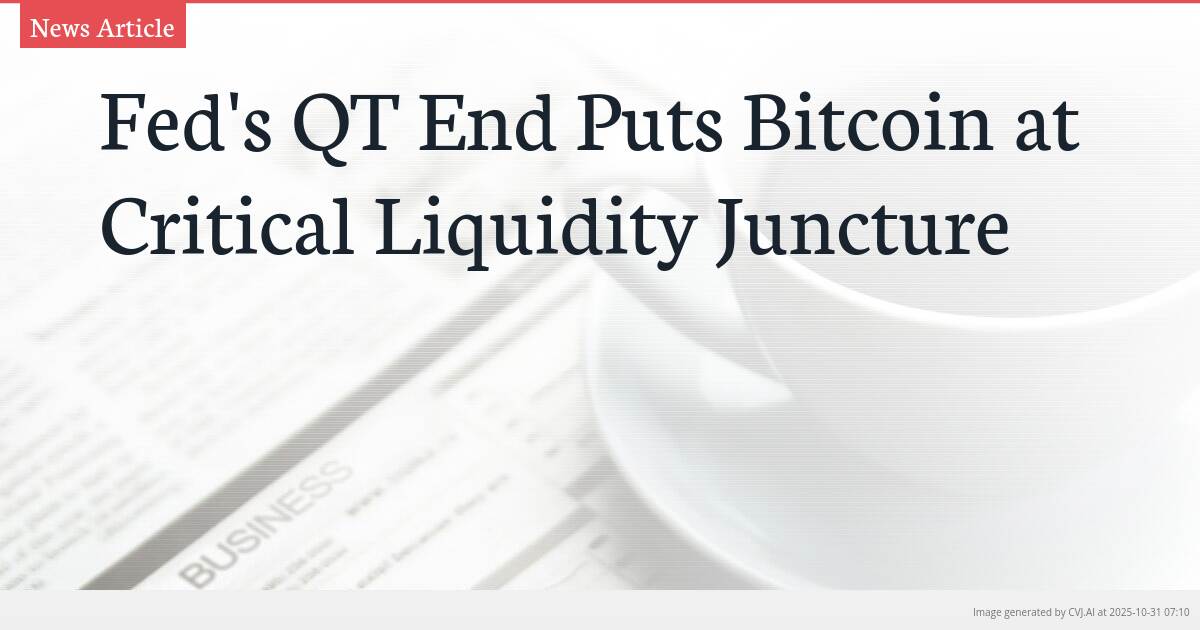This summary text is fully AI-generated and may therefore contain errors or be incomplete.
Introduction
The Federal Reserve’s decision to end quantitative tightening has placed Bitcoin at a pivotal liquidity crossroads, creating both opportunities and challenges for the cryptocurrency market. While short-term volatility persists with Bitcoin ETF outflows totaling $197.5 million and Ethereum funds seeing $66.2 million in withdrawals, analysts suggest the current market differs significantly from 2019’s post-policy environment due to higher interest rates and substantial institutional participation. The long-term outlook remains decidedly bullish, with experts forecasting Bitcoin could reach $200,000 by Q3 2026 if macroeconomic conditions remain favorable.
Key Points
- Current interest rates at 4% provide more 'built-up energy' for risk assets compared to 2019's 2.5% rates
- Bitcoin ETF flows show cautious sentiment with $197.5M in outflows for BTC and $66.2M for Ethereum funds
- Analysts project Bitcoin could reach $200,000 by Q3 2026 if macroeconomic and geopolitical conditions remain favorable
The Fed's Pivot and Its Double-Edged Sword
Federal Reserve Chairman Jerome Powell’s recent comments signaling an end to the central bank’s balance sheet reduction, known as quantitative tightening, have placed the crypto markets at a critical inflection point. Historically, such transitions have initially been met with volatility but ultimately paved the way for capital flows into higher-yielding investments as easing begins. According to experts who spoke with Decrypt, this process is fundamentally bullish for risk assets like Bitcoin, though the immediate market reaction has been cautious.
The current situation presents a complex picture. Riya Sehgal, research analyst at Delta Exchange, noted that “despite a 25bps rate cut, traders are dialing back expectations for further easing, now pricing a lower chance of another cut in December.” This cautious sentiment is reflected in ETF flows, with Bitcoin funds experiencing $197.5 million in outflows and Ethereum funds seeing $66.2 million in withdrawals. The market appears to be weighing the potential benefits of increased liquidity against concerns about the timing and scale of future Fed actions.
Why 2019 Comparisons Fall Short in Today's Market
While the current backdrop bears some resemblance to 2019—featuring U.S.-China trade tensions, political pressure on the Fed, and a dovish central bank stance—analysts emphasize crucial differences that could lead to divergent outcomes. Ryan Lee, chief analyst at Bitget, told Decrypt that “the parallels are clear: tariff pressure, political interference, and a dovish Fed, but this time Bitcoin sits at the center of global liquidity flows.” Unlike 2019’s pre-institutional market, today’s crypto landscape features established institutional participation that could amplify upside potential rather than trigger stress.
Sean Dawson, head of research at on-chain options trading platform Derive, highlighted a key macroeconomic distinction: “Things are quite different from 2019’s liquidity cycle.” He noted that the current interest rate of roughly 4% is much higher than the 2.5% seen in 2019, which means “there’s more built-up energy in the markets that can flow into risk-on assets like Bitcoin if rates were to fall.” This higher interest rate environment creates greater potential for capital rotation into cryptocurrencies when easing occurs, providing a stronger foundation for sustained growth.
Navigating Short-Term Volatility for Long-Term Gains
Despite the optimistic long-term outlook, analysts acknowledge significant near-term challenges. Ryan Lee of Bitget warned that U.S.-China trade tensions and political pressure may cause short-term volatility and lead to a 10% to 15% correction for Bitcoin. This caution is echoed in derivatives markets, with Dawson noting that “options traders are still clamoring for short-term insurance, a sign that the fear from October’s crash remains fresh in the market’s memory.” The combination of geopolitical uncertainty and recent market trauma continues to influence trader behavior.
However, both experts agree that the broader easing cycle sets a supportive tone for risk assets over the longer horizon. Dawson emphasized that “we’re truly in uncharted waters; the current administration is all in on crypto adoption, coupled with the expectation of lowered rates, which bodes extremely well for Bitcoin.” He added that an impending leadership change at the central bank involving a Trump-selected replacement will likely expedite rate cuts, creating a “fiscally loose Fed” that would be “extremely beneficial for Bitcoin holders.”
The path forward appears contingent on specific macroeconomic developments. According to Dawson’s analysis, easing from the Fed is required for Bitcoin to break out of its $105,000 to $115,000 trading range. He forecasts a $200,000 target for the third quarter of 2026, provided favorable macroeconomic and geopolitical conditions persist. This projection underscores the delicate balance between immediate market pressures and the substantial upside potential created by the Fed’s policy shift and Bitcoin’s evolving role in global finance.
📎 Read the original article on decrypt.co

